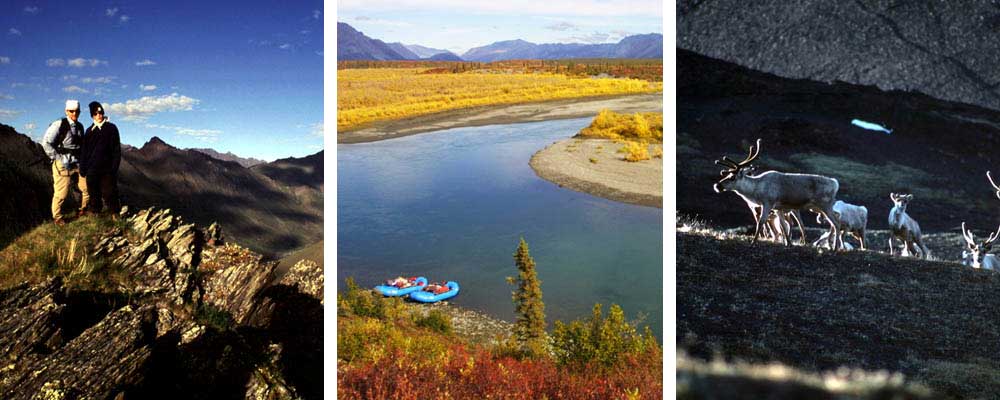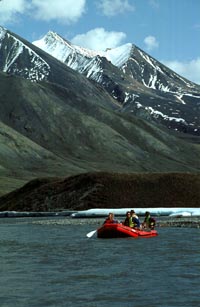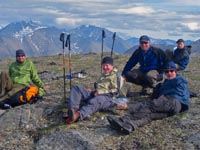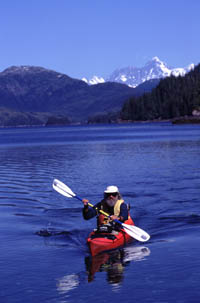
TRIP INFORMATION
About our trips
On all our trips, the emphasis is on garnering the most from your particular experience. Significant attention has been given to provide a comfortable camp and excellent cuisine to complement the day's discoveries. Our mission is to provide you with a relaxing atmosphere so you can most enjoy your great Alaskan odyssey.
All inquiries receive our prompt attention. Full trip descriptions, route details, suggested equipment list, orientation information, plus answers to any related questions are rapidly provided following receipt of a deposit. Wilderness Alaska's former guests (there are likely some in your area) are also available to answer any "What's it really like?" questions.

Float trips comprise of two 14' white water rafts. Each boat has a knowledgeable guide and most boats are rigged as paddle boats with a crew of 3 or 4. Trip size is normally limited to 8 to insure you the highest quality trip with the less distractions possible.
All the trips are casual in nature. Each day is an adventure, we are more responsive to weather and wildlife to determine individual day's activities than prescribed programs developed during the off season.
With 24 hours of daylight, we have extreme flexibility to accommodate this opportunistic schedule. Most of the floats are 40 to 50 miles in length. We normally spend an average of 2 1/2 - 6 hours in the boats which leaves plenty of time to explore or watch wildlife. Most days we spend only half the day in the boats and the other half is either spent on a longer afternoon dayhike or by stopping several times for shorter hikes up knolls or side valleys and to watch the animals spotted along the way. At least two days (usually more) are set aside exclusively for dayhiking. The boats haul enough gear that we can serve up three hearty meals a day comprised of foods that most of us eat at home. Ask the pilots, our coolers are the heaviest in the business! This is clearly the platinum way to go.
No experience is necessary though one should feel comfortable around water. Water safety and instruction is provided and practiced. Folks ranging from 8 to 75 have enjoyed these trips in past.
As we expand the range of rivers we explore, we are increasingly choosing canoes. Some experience is recommended for these trips.
Hiking trips, which are limited to 5 people, are clearly more demanding, because we all are responsible for carrying our own gear and part of the community gear (food, pots, fuel, etc.). On a 10 day trip, packs can weigh around 60 pounds. Of all our trips, these do require some initial physical preparation. We generally walk 4 or 6 miles a day, and in recent years are generally hiking 40 miles in a 10 day trip. All travel is off-trail, using our best option of gravel bars, stream terraces or game trails, at an average rate of 1mph. Consequently, walking in this country requires patience, dexterity and some stamina. On hiking trips too, there are days off for pack-free hikes and climbs and plenty of time each day for relaxing, reflection or exploring.

Below, you will find a key beside all hikes to try to reference them in relative terms of difficulty and demand within our system, remember even easy off trail trips can rival long distance trail hiking for intensity. A means this is the most casual trip traveling fewer miles or less challenging terrain and with more time for dayhiking or lounging. indicate our most demanding trips that require a significantly more ambitious and goal oriented person. means no capes or ruby slippers are required, but at day's end, a sense of accomplishment should sink in (sometimes squarely in the shoulders).

Our Southcentral sea kayaking trips are very much like our float trips, though we are slightly limited in what we carry by the size of our boats, however there is still room for coolers of delicious food and small boxes of hardwood for environmentally friendly 'indian' fires. We have recently upgraded our flotilla and now use Seaward Southwind double sea kayaks. These hardshell boats are roomy, relatively fast and extraordinarily stable, we are very pleased with them. As these trips have become more popular we have tried to broaden the range of experiences you can choose from. There are very easy trips that are great for beginners, others oriented to a bit more travel and finally some epics for seasoned paddlers (all are rated using the same mosquito key mentioned above). Many trips are still appropriate for entry level paddlers, however any boat experience and skills are quite helpful as is a confidence around water.
All itineraries are relatively flexible, adjustable to the group's ability and endurance. Rarely are any of the days long marathon paddles (most days are less than 8 - 12 miles), but rather mixed days of paddling, beach combing, eating and hiking. Familiarity with the country enables us to establish cozy beach camps even in inclement weather. Walking is usually limited to shoreline or along creeks and waterfalls, but there is an abundance of time to peer into the forest to examine the inner workings of the rain forest.
Customized group trips have always been an important part of our business. Every year we organize trips for families, camps or friends. If you have specialized goals or would like to alter scheduled trips dates, please contact us about designing a trip for you. We also can design an itinerary and provide support for you to conduct a trip 'bareback', ask for the 'NO GUIDES, NO GEAR' option.
Experience
As with any endeavor, the better prepared you are, the more you will enjoy it. The Brooks Range, due to its remoteness, is unforgiving. Wilderness Alaska groups traverse some of the most remote areas on the continent and help is always a long way away. It is a rare and attractive feature, but one commanding respect. Consequently, it requires somewhat greater conditioning than similar wilderness ventures.
Previous experience is not required, however it does help one make more informed choices before and after the trek begins. Similarly, an adventuresome spirit and tolerant attitude are also quite helpful. Prince William Sound, on the other hand, is a great place to 'get your feet wet' so to speak. A more immediate support network exists here. The shorter length trips provide an excellent platform to develop outdoor skills that can be tested and built upon on more rigorous trips later. The boats enable us to ride in style with an extra level of comfort. Upper body preconditioning and a tough backside pay large dividends. Please consult with us for suggestion on how best to prepare for your outing.
Equipment
Quality equipment will help assure that a trip is safe and enjoyable. Equipment failures in remote areas are frustrating at best and can be dangerous. Particular attention should be given to older gear that may be in need of some important maintenance and footwear that may either be too old to survive the rigors of a long trip or too new and not properly broken in. This is particularly applicable to heavier all leather boots. It is similarly important to familiarize yourself with new gear. A suggested equipment list and other details will be sent following receipt of your trip reservation. Tents, sleeping bags, packs and other technical gear can be rented for an additional fee if you like.
What to Expect
Plan to arrive in the host city the day before your trip departs. A Wilderness Alaska representative will meet with you there to insure that all has arrived well and intact, provide orientation regarding the following days logistics and offer help with last minute equipment adjustments as well as suggestions for local sightseeing and available activities. Travel usually begins early the next day and can be fairly involved - a measure of patience goes a long way. Arctic travel is heavily dependent on weather. There is always a chance that flights in and out of the mountains may be delayed. Prince William Sound boat pick-ups are very rarely disrupted. In any event, please do not schedule your arrival to and departure from Alaska too closely.
What's Included
The quoted price includes all community equipment, boats and paddling gear, food and kitchen gear, guiding and visitor fees and transportation costs from central gathering city (Anchorage for Prince William Sound trips and Fairbanks for Arctic trips). Tents, sleeping bags, packs and other technical gear can be rented for an additional fee. Although spending money is not needed, it can be handy for incidental purchases in the villages we visit in transit to and from our trips.
Weather
The Arctic
Summer weather in the Arctic is elusive, intense, fleeting and quite unpredictable - like a bipolar fashion model in a department store. Our advice is to ready yourself for a broad range of possibilities, 25 and snowing to 85 and cloudless, and be glad when you experience a mundane median. I have experienced snow during every month of the summer as well as had raincoat free, shirt's off trips. A detailed equipment list will be sent to you after you have signed up for a trip which will outlined the most effective clothing to bring and remain comfortable. In the links section there are suggestions to where you can find it.
So what's it like? Technically the Arctic is a desert receiving less than 15" of precipitation annually. Unfortunately most of it comes in the summer. The compensation for this is the ceaseless sunshine with no sunsets from May 2 to August 1 and long hours of twilight afterwards.
July can be like June only some days the temperature is higher. The bugs will be at peak hatch during the first three weeks. Toward the end of the month it is more common to see weather systems moving from the west and having less intense precipitation over longer periods of time. These systems can be on three day cycles punctuated with periods of clearer weather. The lagoons and near shore break up.
During August these cold fronts from the west are more common and temperatures begin to drop. Of the three months, this is the coolest and wettest. Even at its wettest, the precipitation is intermittent and there are windows when we can break and set camp with relative ease. This weather also dampens the bugs and accelerate the autumn colors. Late in August the skies tend to clear and there is an "Indian Summer". Daytime temperatures can return to the mid sixties and the precipitation switches back to the briefer orographic storms. Night time temperatures are coldest during clear optimum aurora viewing evenings and we frequently find frost awnings in the morning.
With luck the Indian Summer continues through the first week of September. When this bubble bursts freeze up and shattered snow showers are the order of the day.
Prince William Sound

This is a northern temperate rain forest cool marine environment, expect precipitation. It is the precipitation that makes the wonderful glaciers and magnificent trees that we've come to see. Temperatures here are more moderate, Highs may reach to the low 70s but are more normally in the 60s. Lows likewise rarely drop below the mid 40s and are more normally in the 50s.
As long as you have an effective rain management plan this is fairly benign environment. We suggest that you bring two sets of clothes, paddling garments and camp gear. During the clear weather (we do have this, its not completely uncommon) these two sets can be integrated. But if you experience wet weather, it is nice to have a layer of fleece that you wear in the boat under your paddling jacket and rain pants. And when we set camp you can remove these garments if they have gotten damp and put on a dry layer. We will have a cozy screened camp kitchen tent and suggest that you bolster your tent with an additional tarp to insure that you remain comfortable on land. I bring a paddling jacket and a rain coat for shore. The equipment list you receive will cover all of this.
April and May are the driest months in the Sound Prince William Sound . Unfortunately shore don't clear of snow until mid May. May and early June can have sensational weather with relatively warm dry days. As the summer progresses expect more rain and by late August the weather can be come quite tempestuous. Make sure that your rain gear works. Trips near glaciers are obviously colder than boreal or island locations. Daily breezes or wind are also quite common, thus a good wind or paddling jacket is a great garment to have. Early in the summer weather tends to be more orographic and predictable. In fact late evening can be the best time to travel to avoid wind and waves By mid August, the winter storm track returns and weather turns cranky and unpredictable quickly and for extended periods. This is why our trips retreat to the more protected fiords later in the summer. During May and June it will be virtually daylight the entire time. Sometime in July night returns, but not really in earnest until the end of the month and artificial light is mandatory. Bugs begin to hatch in mid June and are worst in July. By August mosquitoes are all but gone, but gnats persist.
